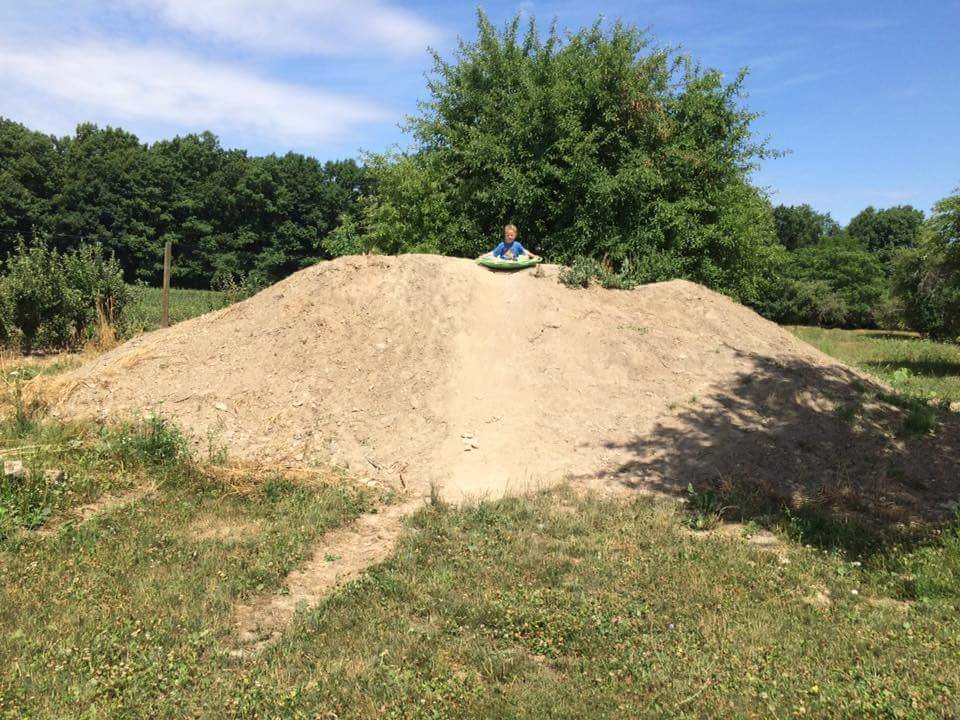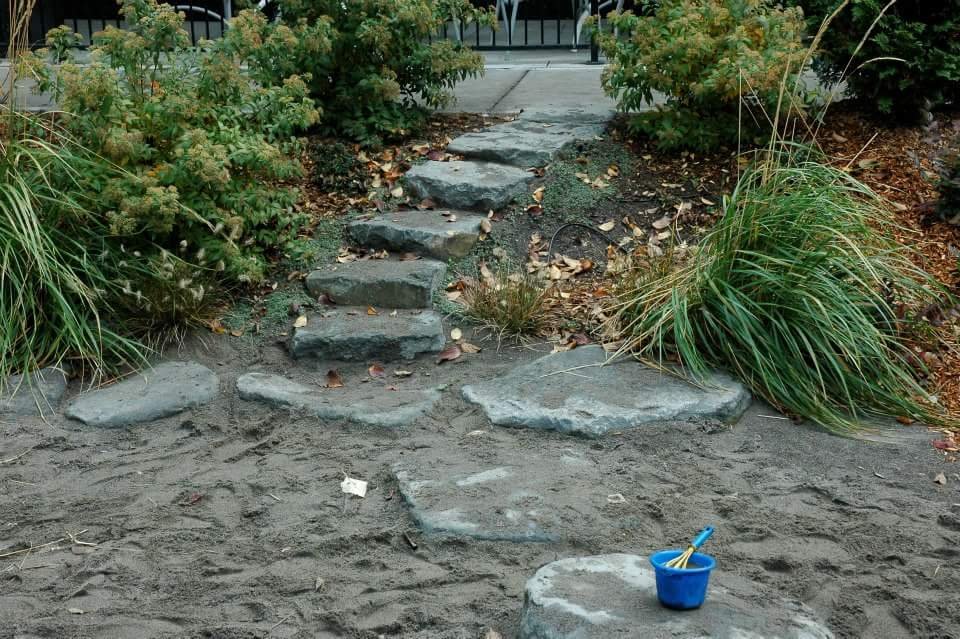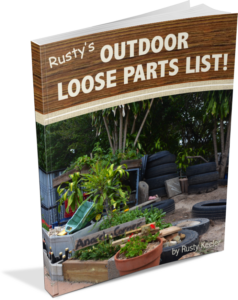The best play spaces for kids are often accidental and undesigned (or, at least, not designed for play). Think of vacant lots full of makeshift baseball bases, forests with kid-built lean-tos, even public squares that youth use for skateboarding.
That said, sometimes those spaces aren’t available. What then? It’s too easy for us adults-in-charge to settle for “good enough” playscapes that we’ve designed for what we think children like, rather than their actual needs. One of my favorite ways to evaluate the play opportunities on a playcape is through asking myself, “What can children do here?” and, more importantly, “What can’t they do?” It can be hard to pinpoint things children can’t do on a site because you don’t see it! I like to use Bob Hughes’ “16 Play Types” to check if there is a wide variety of play happening.
Bob Hughes created a list of different play types for playworkers to use to think about play. It’s just one of many ways play has been divided into categories. I’m working from the list from fellow playworker Morgan Leichter-Saxby’s blog here. Bob Hughes’ play types are not always clearly defined, and I will not be using this document to talk about the subtle differences, rather, I hope to suggest some broad ideas to prompt further thinking.
Here are a few ideas to jump-start your own thinking about how to provide for a wider variety of play types:
Symbolic Play – play which allows control, gradual exploration and increased understanding without the risk of being out of one’s depth.
Symbolic play involves open-ended materials: pretending a pinecone is a baby or a pool noodle is a sword. If you don’t see symbolic play happening you might take a look at what loose parts you have available for play and if it’s clear to the children that they may pick them up and use them. Sometimes putting objects in a different context can help! For example, pinecones on a piece of cloth or chalk by the blocks of wood.
Rough and Tumble Play – close encounter play which is less to do with fighting and more to do with touching, tickling, gauging relative strength. Discovering physical flexibility and the exhilaration of display.
Rough and tumble play can be a tough one for some sites. I love Teacher Tom’s realization that if he was spending his day saying, “Now is not the time for wrestling.”, then as the teacher his job might be to take the children’s cue and make some time for wrestling happen! Educating staff about rough and tumble play is a start. Having enough space is a great help too – and I’ve seen some schools bring out wrestling mats as a designated wrestling area to help manage the play if that’s what’s needed to help staff feel more comfortable with it.
Social Play – play during which the rules and criteria for social engagement and interaction can be revealed, explored and amended.
Communication Play – play using words, nuances or gestures for example, mime, jokes, play acting, mickey taking, singing, debate, poetry.
I’m putting social play and communication play together. Social play is just play where you are talking with others. It has more of a focus on communication as a means to an end, such as when communicating in order to build a fort. With communication play, on the other hand, the communication is the play such as with rhyming, teasing, riddles, and even texting and emailing!
I’ve found that the most helpful element for social and communication play is enough time spent playing that you don’t feel rushed and can settle in for a long play with your friends. Anything that is helpful for spoken communication can help social play: making sure the playspace isn’t overcrowded so kids can hear each other and find a place to be, seating and semi-private areas (either made by children or provided) for hanging out.
If we’re talking older kids who can write and read, add a chalkboard (or a whole chalkboard wall!) where they can write and joke. We sometimes use “The Sharpie Test” in playwork as a way to talk about a playground truly belonging to children: if they can write on it with permanent markers with no repercussions (from anyone other than their peers!) then it is getting close to being truly theirs. If that is truly the case on your site you will see lots of writing as part of the play (but it’s not possible everywhere)! Chalk is a great middle ground because it easily washes off.

Communication play: passwords.
Creative Play – play which allows a new response, the transformation of information, awareness of new connections, with an element of surprise.
One element of creative play is creating things. Again, loose parts are helpful! Especially the tools you can use to change the things: tape, paint, string. Add paintbrushes near the mud pit (or water source) and you might see painting; add surfaces, like wood scraps or logs on which to create masterpieces.
Socio-dramatic Play – the enactment of real and potential experiences of an intense personal, social, domestic or interpersonal nature.
Role Play – play exploring ways of being, although not normally of an intense personal, social, domestic or interpersonal nature.
Fantasy Play – play which rearranges the world in the child’s way, a way which is unlikely to occur.
Imaginative Play – play where the conventional rules, which govern the physical world, do not apply.
Dramatic Play – play which dramatizes events in which the child is not a direct participator.
I’ve put socio-dramatic play, role play, fantasy play, imaginative play, and dramatic play together (this .pdf document gives examples of the differences between them). They all have the common thread of imagining things that are not there. Costumes (or cloth and scissors to make costumes) and loose parts are helpful. A stage can be a great addition for children who want to play out their stories for an audience. Similarly, ways to make small structures or providing small structures that can house the play lends itself well to imagining different realities whether they be house, grocery store, wedding, dragon lair, castle, or army base. With loose parts, generic items and structures can be modified by the children for what they need that day.

Socio-dramatic play: hidden kid-built fort of cloth, pallets and tires.
Deep Play – play which allows the child to encounter risky or even potentially life threatening experiences, to develop survival skills and conquer fear.
Are there places the children can climb high enough to feel their hearts beat faster? Or go fast enough to forget anything else exists? Hills, heights, and things that can move fast help provide for some kinds of deep play. Deep play – even mild deep play – can be difficult to incorporate when your own fears get in the way! But knowing that it’s important might help you allow sledding in the winter or jumping off of the climbing structure.
Exploratory Play – play to access factual information consisting of manipulative behaviours such as handling, throwing, banging or mouthing objects.
For exploratory play it is helpful to have a variety of materials, especially real materials: stones, pieces of wood, pots and pans, cloth. Variety in texture and sound will make objects more enticing to explore.
Locomotor Play – movement in any or every direction for its own sake.
Locomotor play is the play that most fixed-equipment playgrounds were designed for: sliding, jumping, hanging – moving. If you’re reading this, I can trust you already realize that a playground needs to provide for a variety of play types, not just locomotor! On the other hand, it’s increasingly common to take out swings and merry-go-rounds, seesaws and monkey bars because of safety concerns, effectively reducing the variety of movements the children can do. An easy way to add some of that back is to use cloth to make temporary swings. They work well spun up and also swinging side to side. Ropes can also be strung between trees or posts to hang on. Planks are also a great loose part for all sorts of uses; for locomotor play, they can be balanced on or turned into a seesaw. Hills and topography change is also a great element for rolling down or running on.

Locomotor play: sand hill sledding.
Mastery Play – control of the physical and affective ingredients of the environments.
When I think of mastery play and space my first thought is digging. Sand and water and dirt and stones can be moved and engineered to change space. Constructing shelters also falls under mastery play, so, depending on your site: wood and nails, cardboard boxes, sticks and rope, cloth, etc. You can also think creatively about the elements of the environment – how about rolls of streamers when it’s windy, or kites? Pieces of clear colored plastic are fun in the sun, or magnifying glasses to burn designs on wood or leaves.

Mastery play: cooking in a giant sand pit.

Mastery play and communication play with loose parts: walking on a plastic culvert tube.
Object Play – play which uses infinite and interesting sequences of hand-eye manipulations and movements.
I left object play separate even though it is very related to other types of play because this is often one that is undervalued by adults. You know water-bottle flipping? That’s object play! Object play can often look like doing the same thing over and over but the more you look, the more minute variations you will see. And since it’s play, it’s worth providing for! Design-wise, allowing materials to flow from one area to another can increase play value: for example, balls down the slide.
Recapitulative Play – play that allows the child to explore ancestry, history, rituals, stories, rhymes, fire and darkness. Enables children to access play of earlier human evolutionary stages.
I quibble with the definition of recapitulative play as its own distinct play type, but it brings up fire, which wasn’t mentioned yet. If it’s possible it can be so amazing to have fire incorporated somehow. I’ve seen fires for cooking and warming oneself, little candle flames and matches for fire play, fire contained in metal bowls and fire to melt pots of crayons into wax. It’s not possible everywhere, but when it is, fire can be very special.

Recapitulative play, creative play, and mastery play: melting crayons over a fire.
It is important to note that just because you do some of the things above won’t mean you’ll necessarily see that kind of play, neither is it considered play if you run adult-led versions of any of these. These interventions are intended to broaden the array of options. The choice and possibility are the important parts.
The above are just a few ideas to get you started thinking about play types. Often, the children will be your best guide to what kind of play they want to be able to engage in: follow their lead! Sometimes, a change in perspective or a change in the environment is all you will need to make it possible to say, enthusiastically, “Yes!”.

